#the world of kbp
Explore tagged Tumblr posts
Text
it's tough being a variable bit rate mp3 in a world of 320 kbps files
38 notes
·
View notes
Text
F-Zero Soundtrack Collection: "Drop the Zero"
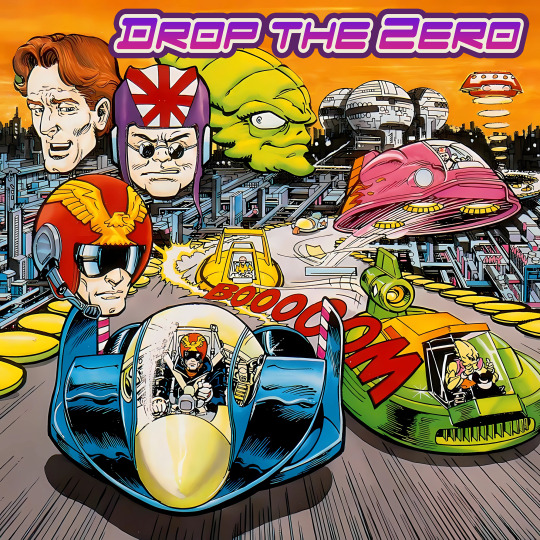
The people have spoken! According to a poll on my Discord server, "F-Zero" is one of the absolute top franchises that needs its soundtracks immortalized. I agree - It's a must!
Gamers from all over the world had their wigs blown right off by the relentless speed and action of the original game that pushed the Super Nintendo to its limits. From there, the characters appeared in manga, anime, Nintendo Power features, and (of course) future sequel titles.
But did you realize there were Japanese exclusive follow-ups? Every single game is included here, alongside featured themes from the retro Smash Bros. games.
And did you know that there were several official arrangement CDs released? Those are available as well, from the reconstructed tunes on "F-Zero X Original Sound Track" and "Nintendo Super Famicom Game Music," the thrashing music of "F-Zero X Guitar Arrange Edition," the Jazz versions of "T Game Music Album #13: F-Zero," and even the mellow piano covers on "Tanoshii Beyer Heiyou Nintendo Super Famicom Game Music."
No duplicates here! If any game or soundtrack shared a song, then only differences are included. For example, the F-Zero GX (GameCube) and AX (arcade) titles had largely the same soundtrack, but there were a few exclusive songs in the arcade version, so those exclusives are present rather than duplicating the whole soundtrack twice).
As games in the series or related material reaches the 15 year old mark (like the F-Zero content in 2012's "Nintendo Land" will in 2027), I will add those to this archive as well.
Download it here:
Running time: 11 hours, 53 minutes Format: MP3 (320 kbps) Number of tracks: 283 Filesize (uncompressed): 1.96 GB
#f-zero#fzero#f zero#f zero x#f zero gx#ost#video game ost#game ost#vgm#videogame music#video game music#game music#game soundtrack#soundtrack#soundtracks#retro game#retro games#retro#video game soundtrack#retro gaming
377 notes
·
View notes
Text
So I have “by the seaside” as my alarm clock noise and it hurts me because every time I hear it I have a visceral reaction, I am unable to sleep through it, it’s the absolute most horrible sound in the world. But I have to keep it because it’s the only alarm I’ve found that does it’s job. Which means I have to start every day feeling unpleasant and stressed. But at least I start the day.
4 notes
·
View notes
Text
How to Convert Your CDs to Digital Without Losing Quality
In today's fast-paced digital world, the importance of preserving our cherished music collections cannot be overstated. Many people are transitioning from physical media like CDs to digital formats, seeking convenience and accessibility. The process of converting CDs to digital without losing quality, however, can often seem daunting. Understanding the right methods and tools to use is essential for a seamless transition that maintains the integrity of the original recordings.
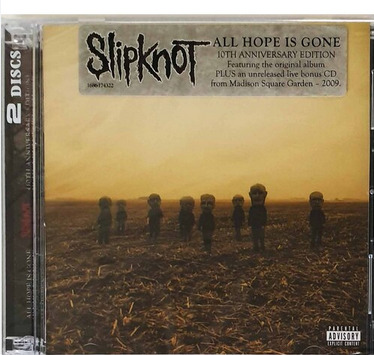
Understanding the Importance of Quality Preservation
When converting CDs to digital formats, the primary concern is often around the quality of the audio. Unlike streaming services that may compress audio files and potentially reduce quality, converting your CDs using the right techniques can preserve the original sound as closely as possible. The key is to choose the right format and settings for your digital files. Formats such as FLAC (Free Lossless Audio Codec) or WAV (Waveform Audio File Format) are favored for their capability to retain the full fidelity of the audio. This means that listeners can enjoy their music as it was intended, free from the artifacts of compression that can detract from the listening experience.
Additionally, one must consider the equipment used during the conversion process. High-quality CD drives and audio interfaces can make a significant difference. Investing in a good external CD drive, for instance, can ensure that the data is read accurately from the disc, minimizing the likelihood of errors that could affect the final product.
Choosing the Right Software
The choice of software plays a crucial role in maintaining audio quality. There are numerous programs available, ranging from free options to premium software that offer advanced features. Programs like Exact Audio Copy (EAC) and dBpoweramp are well-regarded in the audiophile community for their ability to rip CDs accurately while correcting for any errors that might occur during the ripping process.
EAC, for example, employs a method called secure ripping. This process involves reading the data multiple times to ensure accuracy, which is particularly important for older CDs that might have scratches or other imperfections. By using such software, users can significantly reduce the risk of losing audio quality, ensuring that each track is converted with the utmost fidelity.
Optimal Settings for Conversion
Once you have selected the appropriate software, the next step is to configure the optimal settings for conversion. While it may be tempting to simply choose the highest bitrate available, this is not always the best approach. A bitrate of 1,411 kbps is standard for CD audio, and using a lossless format will retain this quality. When using lossy formats like MP3, it is recommended to use a bitrate of at least 256 kbps to ensure that the audio remains as close to the original as possible.
Furthermore, it is essential to pay attention to the sample rate. CDs use a sample rate of 44.1 kHz, so maintaining this rate during conversion is critical for preserving audio quality. Ensuring that your software is set to the correct sample rate and bitrate will help achieve the best possible results.
The Conversion Process
With the right tools and settings in place, the actual conversion process can begin. First, insert the CD into your CD drive and open your chosen software. Once the software recognizes the disc, you can select the tracks you wish to convert. It is advisable to convert the entire album in one go, as this maintains the continuity of the music and can simplify organization later on.
After selecting the tracks, initiate the ripping process. This may take some time depending on the length of the album and the speed of your CD drive. During this time, it is advisable to avoid using your computer for other intensive tasks, as this can affect the accuracy of the conversion. Once the software completes the ripping process, it will usually provide a summary of the action taken, including any errors encountered during the process.
Organizing Your Digital Library
After successfully converting your CDs to digital format, the next step is organizing your new digital library. Proper organization will allow for easy access and enjoyment of your music. This can include renaming files in a consistent manner, such as using artist name and album title, and ensuring that metadata is correctly tagged. Metadata typically includes information like the track title, artist, album name, and genre, and it is vital for searching and sorting your music efficiently.
Many media players and libraries, such as iTunes and VLC, allow for easy management of your digital music collection. Utilizing playlists and grouping songs by artist or genre can enhance your listening experience, making it straightforward to find your favorite tracks.
Conclusion
Converting your CDs to digital without losing quality is achievable with the right knowledge and tools. By understanding the importance of quality preservation, selecting appropriate software, configuring optimal settings, and organizing your digital library, you can enjoy your music collection in a convenient format without compromising on sound fidelity.
For those looking to capture and preserve their musical memories in the best possible way, Rerun Records & Photography offers professional assistance. Through their expertise, they can help ensure that your music collection is converted and archived with the utmost care, allowing you to enjoy your favorite tunes for years to come.
2 notes
·
View notes
Text
Summer Winter Reading/Arting/Writing Tag ⛄
I was tagged by @writeouswriter @writernopal and @druidx so long ago that it was summer, but rather than wait a whole year, I'll just call this one the winter edition 😭 Thanks for the tags and your patience, you guys! <3

Describe one creative WIP project you’re planning to work on over the winter.
Slightly boring answer, but I definitely want to crank out a serious amount of Invisible Girl draft 2 this winter! The tantalizing thought of having something concrete is at my fingertips and I cannot wait to see it through. :)
Recommend a book
An Ember In the Ashes by Sabha Tahir! This series is one of my favorites to reread, featuring a political fantasy set in an Ancient Rome inspired world. Tribal storytellers, mythical creatures, loyal sacrifices, highly skilled fighters, a world ending event or two, and more await you here!
Recommend a fic
Really?? Out myself here?? ...fine. 😂 Good Enough - Chapter 1 - SixOfProse - Six of Crows Series - Leigh Bardugo [Archive of Our Own] <<a really fun look at some post canon for any Six of Crows fans out there...
Recommend music
Here's a few I've listened to recently:
Everywhere, Everything - YouTube -- Noah Kahan
Concerto in F - YouTube -- George Gershwin
Lauren Spencer Smith - Bigger Person (Lyric Video) - YouTube
Chet Baker - 04 - I Get Along Without You Very Well - The Best Of Chet Baker Sings HD1080 320 kbps - YouTube --Chet Baker
Share one piece of advice!
I feel like there's nothing I can say that hasn't been said already, but maybe don't stop moving. If you're stumped on what to write, open a different wip and work on that. If no words come, go craft/draw/create elsewhere. If you don't feel like creating, go read read read. The ideas have come before and they'll come again. They'll be back. 💛

I'd love to hear everyone's version of this, so if you see this post, consider yourself tagged <3 Also @avrablake @sleepyowlwrites @blind-the-winds @liv-is @outpost51 @ashen-crest @talesofsorrowandofruin?
13 notes
·
View notes
Text
Bubblegum Black mega-ish chapter notes: Chapters 9-12
Yes, that's right! If you only follow me through tumblr, you probably thought I was dead! But no, I just chose to hold off on my usual notes-post until I'd finished the ridiculously long and complicated battle between Hotel Moscow versus D-Company. So the notes will be for four fucking chapters now.
Also, for the record, I'm probably going to stop just posting these on tumblr, and start mirroring them to SpaceBattles or Sufficient Velocity. I mean, how many people have a tumblr account that will let them read all the way through? Not many, I imagine. Well, let's get into it.
CHAPTER 9
The OCs: So! New characters, hm? I don't think they'll be playing a major role in the fic for the most part, but once I figured that Balalaika would have experience operating a powersuit - not because of any particular reason beyond the assumption that they existed during the Kazakh conflict, and then that she needed a way to stand alongside the Sabers in mecha-fighting - then I thought it would be fun to have other suit operators that were Balalaika's comrades-in-arms and thus people the Sabers could fight alongside too. It helped me, in turn, figure out how to humanize Hotel Moscow just a bit, having these specific people with specific talents.
KB-43 Oktyabr: The predecessor to the ADP's K-suits, the Model 43 'Walking Armor' was drafted as a mechanized system in between World War 3 - when light power armor was used for individual infantry protection and lugging heavy equipment - and the Kazakh conflict. UralVagonZavod, the developers, were flush with Chinese money and talent, the alliance between China and Russia supposedly ironclad - the only problem was that Russians hated UVZ for their top-attack vulnerable tanks, the ones that were not so impressive in the Ukraine war and were even less impressive during the botched attacks on Finland and Poland. Building the first powersuits, then, was a last-ditch attempt to not have Russia's legendary tank-building house liquidated and folded into other parts of the Rostec state defense conglomerate. It worked. KB-suits might require more maintenance than other powersuits, might lack the versatility or strength of more modern K-suits, but they're a bit like AK rifles in that regard. They're just fucking everywhere. Also, they're literally just the Russian Arms Boris ACPA from Cyberpunk 2020:

KB-65 Nasyschat: 'Saturate' in Russian, appropriate for its light artillery capabilities. This is the Russian Arms Bombardier ACPA from Cyberpunk 2020. Note that in both armor's cases I've severely reduced the amount of weapons they carry. This can either be read as a concession to Hotel Moscow not having the logistical might of the old Russian army, or just acknowledging that the amount of weapons an ACPA can carry is fucking goofy. Most ACPA could squish even 2077 Adam Smasher with ease. It's wild.

GSh-30-V: The 30mm cannon the Boris uses in CP2020, but built by the KBP boys as a rifle (hence the V) patterned off old Gryazev-Shipunov autocannons. I'm sure that this realistically does not make sense. Eh.
KPV: 14.5mm machine gun. Note my joy in turning old Russian guns into powersuit weapons. Ha ha ha. hoo hoo hoo. hee hee hee.
Semi-auto incendiary-flechette shotgun: This, in retrospect, makes no sense. The ammo doesn't make sense and neither does the use of shotguns to take down armor. Well, what the hell. Once again, I blame Cyberpunk 2020's humongazoid 'borg / ACPA weapons, specifically the United Arms CLAW, a 4-gauge mag-fed autoshotgun. If anything I've toned that fucking monstrosity down a bit by making it semi-auto. Kinda like the KS-23, another Russian goofy-gun, now that I think about it.
Instrument Vzloma: Breaching instrument. Which is hardly an appropriate term for a man-sized axe wielded by a giant powersuit, but what the hell.
Balalaika's speech, getting inside Balalaika's head in general: I actually don't want to say much here; the speech, and her internal monologue, should speak for themselves.
Tou Chi The Blaster: Real Black Lagoon character, for those of you who don't know the manga / anime. Kinda one of a million loser gunmen with big attitudes and bigger addiction problems in Roanapur.
More Regrets: Considering how big the missiles are in IRL anti-ship missile boats, I think my image of almost a missile turret for the 2069 Black Lagoon is a smidge off. Obviously the boat's much bigger than an Elco, but its ordnance is much bigger too, right? Yeah. Well, what the hell. Sci-fi tech.
Rock's guns: The shotgun in question is an SASM-18, a futuristic retread of the mag-fed semi-auto SPAS-15, using a motorized cocking system to replace the pump-action switch for specialty rounds so one need only pull the trigger. Oh, and eight shells instead of six. As for the Type-37... I have plans for a detailed look at what's basically Rock's 'hero gun' going forward, even if said gun is somewhat impractical. But I kind of want to put them in an actual chapter instead of dumping them to the side here. So let's put a pin in that for now.
Lena meditating: I know I've said this before someplace, but I'll say it again: It's strange that 2032 Linna's prowess as a melee expert supposedly comes from her aerobics and dance training, and not just plain ol' martial arts. (and then 2040 Linna has no talents either way, but that's beside the point). I still think it'd be nifty if Lena had martial arts training, was still a vain materialistic yuppie but also good at keeping her body in tip-top shape through various techniques. Fuck, now I'm remembering a bit I read of Shawn Hagen's BGC Shadowrun crossover where she just got muscle grafts. How tasteless. And, again, yes, the Sabers are superheroes, of course they're going to rescue people soldiers would write off as dead.
Duhmin, and Roanapur's history: I like this bit of writing. But it explains itself, really. I rewrote the opening of this scene like three times, by the way.
CHAPTER 10
Marya Zaleska: One of Hotel Moscow's big cargo ships (presumably able to carry some weapons at some point) in canon.
Swimmer Rounds: Are apparently a real thing! I think if you look for the most recent Nammo ammunition catalogue you can find them somewhere in there. Wild shit.
Icewolf: So, here's some lore about how hacking works in this cyberpunk-y universe! The old internet was bricked by cyberweapons, not by Bartmoss, and now crude memetic organisms, evolving from those old pieces of software like microbes, are bred, learned from, weaponized for various purposes. In an age where computers are explicitly brain-structured (ie neuromorphic), it makes sense to go for biological metaphors, I think. Like... like Hacker Pokemon? Is that too trite?
Tardigrade: No, there is no prior fic where this type of Boomer showed up, but I really enjoy the idea of the Sabers having had enough adventures that a lot of things that show up in this fic don't necessarily surprise them all that much. Anyway, incoming miniboss encounter!
The Boomer / Powersuit: The thing Balalaika fights here is heavily inspired by the D.D. Mass Production Type, a scribble found in the B-Club and then in the BGC RPG EX book:
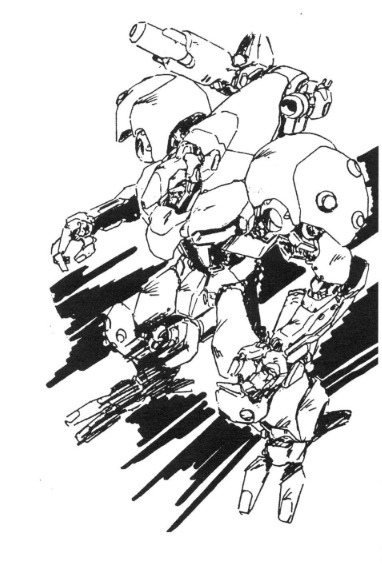
Weirdly enough, according to both the B-Club and the RPG, this was a never-seen design for a Battlemover, but I swear I've seen it in an establishing shot of GENOM Tower's entrance in OVA 6. I don't understand what's going on - is it the same thing? I want to believe it is.
47C Kappa Boomers: Not much to say about these. They're there.
CHAPTER 11
Oh boy oh boy oh boy: Rock finally killed someone himself! What fun! What excitement! I suppose it has to happen in every longer Black Lagoon fic. And I suppose Rock never gets to feel very good about it. And I suppose... what else? I think Revy's reaction was about right here. I really ought to chill on Depression!Rock for a bit, but that'll wait until the next arc.
KA-77: Basically the Russian version of the Bell V-280, the tiltrotor replacement for military helicopters, kitted out with gunship weapons. Fun fact: Tiltrotors don't actually have a worse safety record than helicopters. For a near-future sci-fi setting, they're a much more sensible new VTOL than vectored-thrust vehicles like the Harrier jumpjet or the AVs from Cyberpunk the franchise. Then again, BGC has those really cool-looking enclosed-fan 'aerodynes' the ADP use all the time, so that's an entirely different form of VTOL I didn't use...
Junayd Lakhani: The man himself! He's kind of a preening weenie! That's kind of the point! Also, yes, I resorted to an MGSV-style Fulton recovery system almost as a joke that became a real thing. I do not regret this.
CHAPTER 12
Honestly, I think I've got enough here. Things work out, they explain themselves, and I don't feel like writing extremely long notes for these chapters anymore. Let's just vibe, for now.
5 notes
·
View notes
Text
Hail to the Glorious Twentieth of July! “In peace for all mankind” is the topic of this episode. There is a great deal I could have chosen to talk about, but it can wait for another day. Here is the document with all the goodwill messages, of which I read out a few. The list of world leaders is fascinating — there are emperors, dictators, governments in exile, all pledging their hopes and best wishes. Let us always rededicate ourselves to that end!
Direct link to archive recording [192 kbps MP3, 40 MB]
2 notes
·
View notes
Text
Step-by-Step: How to Live Stream Your Ludo Matches
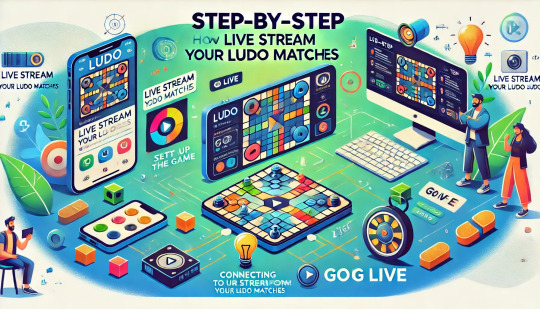
Gaming streams have developed to show the players’ activity, communicate with the audience, and sometimes even earn money. Ludo, a board game quite famous earlier and has even grown popular in this digital world, is no different. Live streaming is a great approach for a Ludo lover if you want to present your matches to the world.
This live stream guide will help you effectively go about live streaming your Ludo matches.
Why Live Stream Your Ludo Game?
Ludo is one of several gamers that are following the trend of live broadcasting. You can: by streaming your Ludo game in real time.
Build relationships with other Ludo players to create a community.
Real-time tips and strategies exchanged.
Acquire followers and earn money from your articles.
Engage viewers in conversation to improve your game experience.
Time to Get Started with Ludo Live Streaming
To live stream your Ludo real money earning games, you need to follow the below-mentioned steps carefully:
Step 1: Choose Your Platform
Before you start streaming, decide which platform you want to use. The most popular streaming platforms are:
YouTube: Known for its vast audience and easy-to-use interface.
Twitch: The go-to platform for gamers, offering extensive live-streaming features.
Facebook Gaming: Great for reaching your existing friends and followers on Facebook.
Instagram Live: Ideal for quick, casual streams with a more personal touch.
Each platform has its features and audience, so choose the one that best fits your needs and where you believe your audience is most active.
Step 2: Set Up Your Streaming Software
To stream your Ludo matches, you’ll need streaming software. The most popular ones include:
OBS Studio (Open Broadcaster Software): Free and open-source, OBS Studio is highly customizable and works on Windows, macOS, and Linux.
Streamlabs OBS: Built on OBS Studio, it offers a more user-friendly interface and additional features tailored for streamers.
XSplit: A paid option with a straightforward interface and powerful features for Windows users.
How to Set Up OBS Studio:
Download and Install: Visit the OBS Studio website, download the software, and install it on your computer.
Create a New Scene: Open OBS Studio and click the “+” button in the “Scenes” box to create a new scene.
Add Sources: Click the “+” button in the “Sources” box to add your sources. For streaming Ludo, you’ll primarily need a “Game Capture” or “Window Capture” source to capture the game window.
Configure Settings: Go to “Settings” > “Stream” and select your streaming platform. Enter the stream key provided by your chosen platform.
Step 3: Optimize Your Stream Settings
To ensure a smooth and high-quality stream, optimize your settings in OBS Studio or your chosen streaming software:
Resolution: Set your output resolution to 720p or 1080p, depending on your internet speed and computer capabilities.
Bitrate: Adjust your bitrate according to your internet upload speed. A 2500-3500 kbps bitrate is suitable for 720p, while 4000-6000 kbps is ideal for 1080p.
FPS (Frames Per Second): Set your FPS to 30 for a standard stream or 60 if you want a smoother experience and have sufficient bandwidth.
Step 4: Prepare Your Equipment
To create a professional and engaging stream, invest in some essential equipment:
Computer or Smartphone: Ensure your device can handle the game and streaming software without lag.
Webcam: A good quality webcam adds a personal touch and helps viewers connect with you.
Microphone: Clear audio is crucial for engaging with your audience. A dedicated microphone is recommended over a built-in one.
Stable Internet Connection: A wired connection is preferable for stability. Ensure you have sufficient upload speed for streaming.
Step 5: Create Engaging Overlays and Alerts
Overlays and alerts can make your stream more engaging and visually appealing. Use tools like Streamlabs or StreamElements to create custom overlays, alerts, and widgets. These can include:
Chat Box: Display viewer comments on your screen.
Alerts: Notify viewers of new followers, subscribers, or donations.
Overlays: Add a professional touch with borders, backgrounds, and other visual elements.
Step 6: Promote Your Stream
Promotion is key to building an audience. Here are some tips to get the word out:
Social Media: Share your stream link on your social media profiles before and during your stream.
Join Communities: Participate in gaming forums, Ludo groups, and other online communities to share your stream.
Collaborate: Team up with other streamers for joint streams, which can help cross-promote your channels.
Schedule Regular Streams: Consistency helps build a loyal audience. Let your viewers know when to expect your streams.
Step 7: Engage with Your Audience
Engagement is crucial for a successful stream. Here’s how to keep your viewers interested:
Interact: Respond to comments and questions in real time.
Be Entertaining: Keep your commentary lively and entertaining.
Encourage Participation: Invite viewers to play with you or suggest strategies.
Step 8: Analyze and Improve
After each stream, take time to analyze your performance:
View Metrics: Check viewer counts, engagement rates, and other analytics your streaming platform provides.
Gather Feedback: Ask your audience for feedback on what they liked and what could be improved.
Adjust Accordingly: Make necessary adjustments to your setup, content, and streaming schedule based on the feedback and metrics.
Step 9: Monetize Your Stream
Once you have built a steady viewership, you can start monetizing your streams:
Platform Monetization: Use built-in monetization features like YouTube’s Super Chat, Twitch’s subscriptions and bits, or Facebook Stars.
Sponsorships: Collaborate with brands for sponsored content.
Donations: Encourage your audience to support you through donations on platforms like Patreon or directly through your streaming service.
Conclusion
Live streaming your Ludo matches can be a fun and rewarding experience. Following this step-by-step guide, you can set up a professional stream, engage with your audience, and potentially earn money. Remember, consistency and engagement are key to building a loyal viewer base.
So, prepare your equipment, choose your platform, and start streaming your Ludo matches to the world.
#ludo money#real money ludo games#ludo real money#ludo real money games#play ludo with real money india#ludo apps#indian ludo earning apps#ludo earning apps#ludo gaming#ludo money withdrawal#live stream
2 notes
·
View notes
Text
FLASH REPORT THIS MORNING: Calambanon Radio Announcer 'DJ Johnny Walker' gunned down from an Unnamed Suspect during an Online TeleRadyo Broadcast of Gold FM (updated as final!!!)

(with reports from 106.1mhz's FMR Babe Radio: Dipolog and DWPM-AM's Radyo 630: Manila)
CALAMBA, MISAMIS OCCIDENTAL -- In a shocking and tragic incident that is recently unfolded in the morning on Sunday (November 5th, 2023 – Calamba local time)… Juan Jerrebel Anggoy Jumalon, popularly known as “DJ Johnny Walker”, a 57 y/o part-time hard-hitting local radio announcer and Disc Jockey [born on August 2nd, 1966], morning radio host and on-board provincial station manager of 94.7mhz’s Gold FM: Calamba was shot dead inside on his own home radio booth at Purok 2, Brgy. Don Bernardo A. Neri, Calamba, Misamis Occidental during an exclusive Facebook live video broadcast of his local morning radio program 'Pahapyod sa Kabuntagon’ (Early Morning). This devastating event has sent shockwaves throughout the local Calambanon community and the radio broadcasting industry in Misamis Occidental.
DJ Johnny Walker, a beloved not-so-fictional figure in the local radio scene, was a prominent personality on 94.7 Gold FM: Calamba. His real name “Juan Jerrebel Anggoy Jumalon”, was known to very few as he went by his radio alias, which had become synonymous with the morning airwaves. More than several years or decades of experience in radio broadcasting, Mr. Jumalon had become an integral part of the local community, providing entertainment, information and a sense of connection to his listeners each day.

94.7 Gold FM: Calamba is an affiliated local FM radio station of the Kalayaan Broadcasting System Inc. (KBSi), and DJ Johnny Walker played a pivotal role in its success. His morning radio program, 'Pahapyod sa Kabuntagon’ was not only known for its entertaining content but also for its community engagement, discussing local & regional issues in Misamis Occidental, and bringing the community together through various interactive segments. This made Mr. Jumalon, a cherished figure among his listeners and colleagues.
In 2014, his personal broadcasting setup of the aforesaid local FM radio station within a decade before the male suspect gunned down to Mr. Jumalon during an exclusive televised interview of DXTE-TV 8's TV5: Cagayan de Oro for News 5. In his personal health reasons back then, Mr. Jumalon was part of the Persons with Disabilities (PWD). Several years later aside from murder case, local and regional issues to be followed when discussing land and business all across the Misamis Occidental area as a motive.
Per the exclusive spot report as obtained by 106.1mhz’s Favorite Music Radio: Babe Radio Dipolog and the selected KBP-member stations in Misamis Occidental, in cooperation with DWPM-AM’s Radyo 630: Manila, when the tragic incident took place during the said LIVE Facebook video broadcast of 'Pahapyod sa Kabuntagon’ around 5:35am on that fateful Black Sunday. This was the world's first online horrific, TeleRadyo-like broadcasting history in Southern Mindanao.



Outside the CCTV video as mentioned, another suspect to be illegally trespassed, who were pretending in disguise as a local listener for a potential public service without a security guard on-duty.


Within the final moments develop, the unnamed male suspect who remains at large and carries a firearm of caliber .45 pistol, disrupted the live FM radio program and shot twice to Mr. Jumalon (even in audible transistor radio simulcast in general), leading to his untimely demise by shooting his lower lip towards his back portion head, then stealing a gold jewelry worth PHP150,000 (U$D2,682.45), and quickly fled off the scene shortly after. Overall, two or three suspects have yet to be later identified on national internet TV. The aforesaid live video on the radio station’s Facebook page on 94.7 Gold FM: Calamba, captured the horrifying event as it unfolded, leaving online viewers in shock and disbelief.
As we gather a lot of information and investigate the circumstances surrounding this tragic event, there is an outpouring of support and condolences from the listeners, avid fans, friends and colleagues of Mr. Jumalon on various disclosed social media platforms. The incident has prompted discussions about the safety of media professionals, particularly in the realm of live radio broadcasting and online media.
Local authorities in Misamis Occidental have embarked on a detailed probe, and the motive is suspected to be a work-related situation. He was now confirmed dead on arrivial (DOA) from a physician doctor named Dr. Geopeter L. Manisan at Calamba District Hospital (CDH) in National Highway, the said city.


A hot pursuit operation of the Calamba Municipal Police Station (CMPS) is on its way, in relation to a brutal murder suspect from an unidentified gun man.
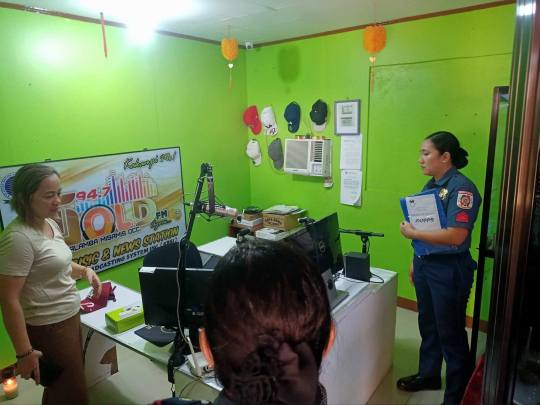


The untimely demise of “DJ Johnny Walker” is a profound loss to the local radio industry and the community he served for several years or decades. His legacy as a passionate radio personality who connected with his audience on a personal level will be remembered and cherished on him. He is one of the 199th journalists killed since 1986 until the present, which includes Central Visayas, Eastern Visayas, Dumaguete City, Mabinay and Negros Oriental, as according to the National Union of Journalists of the Philippines (NUJP).
As the investigation unfolds from the Calamba-Philippine National Police, the community and his fellow broadcasters mourn the loss of a beloved figure and await justice throughout the weekend for this heinous act.
EDITOR's NOTE (as of November 7th, 2023): We edited out for clarification from our previous update, as we all learned from our media friends at Radyo 630: Manila and other KBP-member FM, AM and TV stations in Mindanao to come up with a conclusion.
Amalia Sheran Sharm, Miko Kubota and Ridley Terrance have all fully contributed to this news report.
PHOTO COURTESY for REPRESENTATION: 94.7mhz's Gold FM: Calamba via FB PHOTO BACKGROUND PROVIDED BY: Tegna
SOURCE: *https://www.facebook.com/100064859973484/posts/333407976049356 [Referenced FB News Article via DXJN-FM 105.3mhz's Radyo Bandera News FM: Cotabato] *https://www.facebook.com/100093017771931/videos/356914123385052 [Referenced FB LIVE Video via DXKB-FM 89.3mhz's Radyo Bandera Sweet FM: Cagayan de Oro] *https://www.facebook.com/100077562834152/posts/359801613281930 [Referenced Police Blotter in PR via Arianna Trisha] *https://www.facebook.com/100094088475887/posts/191863797293235 [Referenced FB News Article via DWPM-AM's Radyo 630khz: Manila] *https://www.facebook.com/100075706497836/posts/356802900186590 [Referenced FB News Article via DZMD-FM 100.7mhz's MyFM: Bataan] *https://www.facebook.com/100064616655120/posts/734630538700828 [Referenced FB News Article via The Philippine Star] *https://www.facebook.com/100047471591140/posts/865352015057177 [Referenced FB News Article via Xymon Jeremiah Pedro the 2nd] *https://www.facebook.com/100064282075832/posts/737856285033767 [Referenced FB Captioned Statement Post via Presidential Communications Office] *https://www.philstar.com/headlines/2023/11/05/2309128/misamis-occidental-radio-broadcaster-gunned-down-while-air [Referenced News Article via The Philippine Star] *https://www.facebook.com/100067938276705/posts/669891301952140 [Referenced FB Captioned PHOTO via MOPPO] *https://www.facebook.com/100067938276705/posts/669997835274820 [Referenced FB Captioned PHOTO via MOPPO] *https://www.facebook.com/100064809663843/posts/730885619081754 [Referenced FB Captioned PHOTO via Presidential Task Force on Media Security] *https://www.cnnphilippines.com/regional/2023/11/5/misamis-occidental-juan-jumalon-death.html [Referenced News Article via DXKO-TV 5's CNN Philippines: Cagayan de Oro] *https://pinoytrend.net/2023/11/05/radio-announcer-na-si-johnny-walker-pinatumba-habang-nasa-gitna-ng-kanyang-programa/ [Referenced News Article via PinoyTrend] *https://rmn.ph/radio-announcer-patay-matapos-pagbabarilin-habang-nagpoprograma-sa-calamba-misamis-occidental/ [Referenced News Article via DXDR-AM 981khz's RMN: Dipolog] and *https://remate.ph/radio-broadcaster-binaril-patay-sa-gitna-ng-programa/ [Referenced News Article via Remate]
-- OneNETnews Team
#flash report#national news#calamba#misamis occidental#police report#gunned down#suspect#johnny walker#social media#Gold FM#awareness#OneNETnews
2 notes
·
View notes
Text
What is GSM modem and how it works?
A GSM modem is a device that allows electronic devices to communicate with each other over the GSM network. GSM stands for Global System for Mobile Communications, and it is the most widely used cellular network standard in the world.
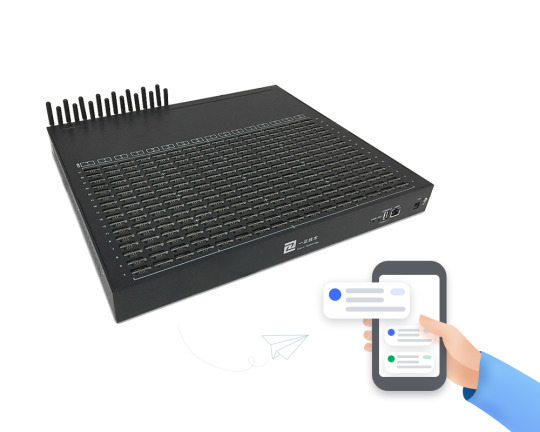
GSM modem work by connecting to the GSM network using a SIM card. A SIM card is a small, removable card that contains your mobile phone number and other subscriber information. Once the SIM card is inserted, the GSM modem can start sending and receiving SMS messages and data.
GSM modem use a variety of protocols to communicate with the GSM network, including:
SMS (Short Message Service): SMS is used to send and receive text messages.
GPRS (General Packet Radio Service): GPRS is used to send and receive data packets.
EDGE (Enhanced Data Rates for GSM Evolution): EDGE is a faster version of GPRS that can be used to send and receive data at speeds of up to 384 kbps.
GSM modem can be used in a variety of applications, including:
Home automation: GSM modems can be used to control home automation devices, such as thermostats, lights, and security systems, using SMS messages.
Machine-to-machine (M2M) communication: GSM modems can be used to send and receive SMS messages between machines. For example, an SMS modem could be used to send an SMS message from a vending machine to its owner to alert them that it is running low on stock.
Business messaging: GSM modems can be used to send and receive bulk SMS messages to customers. For example, a business could use an SMS modem to send SMS messages to customers about sales and promotions.
Emergency alerts: GSM modems can be used to send emergency alerts to people in a specific area. For example, a government agency could use an SMS modem to send SMS messages to people in a hurricane evacuation zone to warn them about the storm.
GSM modem are a versatile and affordable way to communicate. They are used in a variety of applications, from home automation to business messaging to emergency alerts.
Here is a simplified explanation of how a GSM modem works:
The GSM modem connects to the GSM network using a SIM card.
The GSM modem sends and receives data and SMS messages using a variety of protocols, including SMS, GPRS, and EDGE.
The GSM modem communicates with other electronic devices using a variety of interfaces, such as USB and serial.
To use a GSM modem, you will need to:
Insert a SIM card from a mobile phone carrier.
Connect the GSM modem to your computer or other electronic device.
Install and configure the necessary software.
Once the GSM modem is set up, you can start sending and receiving SMS messages and data.
2 notes
·
View notes
Text
The Future of Independent Music: Submit Your Single on Gaana in 2025
In an increasingly digital world, platforms like Gaana have become crucial in the distribution of music. Gaana, one of India’s largest music streaming platforms, continues to be a powerful tool for independent artists in 2025. With millions of active listeners and a vast reach across the country, submitting your single on Gaana in 2025 offers a unique opportunity for independent artists to connect with fans, gain exposure, and generate revenue. This article explores the evolving music landscape and highlights why Gaana remains an essential platform for independent musicians.
Gaana’s Influence on India’s Music Scene in 2025
Gaana has been a dominant force in the Indian music streaming industry for years. In 2025, it continues to lead the market with millions of users. Whether you're an artist from a metropolitan city or a remote town, Gaana offers a platform for you to reach music lovers from all regions of India. The platform’s sophisticated recommendation system and curated playlists have made it easier for artists to be discovered by new listeners.
For independent musicians, Gaana’s broad demographic reach is one of its most valuable features. Unlike international platforms, which may not be as familiar to the Indian audience, Gaana has embedded itself deeply into the cultural fabric of India, making it an invaluable tool for artists aiming to reach a national audience. By submitting your single to Gaana in 2025, you are not just making your music available to millions of listeners but also positioning your work for long-term growth in the music industry.
The Role of Distributors: Deliver My Tune and Other Key Players
When it comes to distributing your music on Gaana, the first step is to partner with a reputable distribution platform. While artists can manually upload their tracks to platforms like Gaana, it's much more efficient to work with a distribution service that can handle the technicalities of submitting your music across multiple platforms, including Gaana. One such distributor is Deliver My Tune, which offers a streamlined process for independent artists. By submitting your single through Deliver My Tune, you can ensure your track is uploaded to Gaana correctly and efficiently.
In 2025, distribution platforms like Deliver My Tune play a vital role in simplifying the submission process. These services manage everything from metadata entry and artwork submission to ensuring your music is formatted to meet the requirements of Gaana. With their assistance, you can focus on promoting your music rather than worrying about the technical side of the distribution process.
Preparing Your Single for Gaana Submission
Before submitting your single to Gaana, you must ensure your track is fully prepared for the platform’s standards. Gaana, like other major streaming platforms, has certain requirements for audio quality and metadata. For your track to be accepted and featured, it should meet the following criteria:
High-Quality Audio Files: The quality of your audio file plays a significant role in how Gaana presents your track. It’s essential to upload your song in a lossless audio format such as WAV or FLAC. Gaana recommends that the bitrate of your song is at least 320 kbps to maintain high sound quality.
Cover Art: Gaana requires a square album cover image for every track. The minimum resolution should be 1400 x 1400 pixels. The cover art is one of the first things listeners notice, so ensure it is visually appealing and aligns with your artist identity.
Metadata Accuracy: Accurate metadata is essential to ensure your song is properly categorized and searchable. Double-check details like the track title, artist name, genre, and any featured artists. Proper metadata ensures your song reaches the right audience.
Copyright Compliance: Ensure you have full rights to your music before submitting it. Gaana will only accept tracks that are free from copyright infringement. If you’ve collaborated with other artists, be sure to obtain the necessary permissions for any shared content.
How to Submit Your Single on Gaana in 2025
Once your track is prepared, it’s time to submit it to Gaana. The submission process itself is relatively straightforward when using a distributor like Deliver My Tune. Here's how it works:
Choose a Distributor: Start by selecting a trusted distribution platform such as Deliver My Tune. Register and create an account on the platform, and follow the prompts to upload your track.
Fill in Your Track’s Metadata: During the submission process, you’ll be asked to enter details about your song, including its title, artist name, genre, and release date. Make sure all information is accurate to avoid any issues during the approval process.
Upload Your Track and Artwork: Upload your high-quality audio file and your album cover image. Both files must meet Gaana’s requirements to ensure your track is processed smoothly.
Submit for Approval: Once everything is uploaded, submit your single for review. Gaana typically takes 7-14 business days to approve new tracks. During this time, your distributor will keep you updated on the status of your submission.
Promoting Your Single on Gaana
After your single is live on Gaana, the next step is to promote it. Gaana has built-in tools that allow artists to share their music across social media platforms, increasing the chances of gaining more streams. Here are some strategies to help you promote your track:
Leverage Gaana’s Playlist System: Gaana’s playlists are one of the best ways for your music to be discovered. By submitting your single through Deliver My Tune, you increase the chances of your song being added to one of Gaana’s curated playlists. These playlists are an excellent way to expose your music to a larger audience.
Social Media Marketing: Use platforms like Instagram, Facebook, and Twitter to promote your single. Post regular updates, behind-the-scenes content, and links to your track on Gaana to generate excitement.
Collaborate with Influencers and Bloggers: Partnering with influencers and bloggers who have a large following can help spread the word about your new release. Reach out to content creators who cater to your music genre and ask them to feature your track.
Engage with Your Fans: Gaana allows artists to engage with their listeners directly through their profiles. Respond to comments, create playlists for your followers, and keep the conversation going to build a loyal fanbase.
Monetizing Your Music Through Gaana
One of the significant benefits of submitting your single on Gaana in 2025 is the opportunity to monetize your music. Gaana offers a revenue-sharing model for both free and premium users. Here’s how you can earn from your music:
Ad-Supported Streams: If your music is played by free users, you will earn a share of the ad revenue generated from those streams. The more streams you get, the more you can earn.
Premium Subscription: Gaana offers a paid subscription service, and premium subscribers can access ad-free content. As an artist, you will also earn a portion of the revenue from premium subscriptions, giving you multiple income streams.
Global Reach and Opportunities: Gaana’s international audience means you can potentially earn revenue from listeners outside India as well. This global exposure can open doors for international collaborations and sponsorships.
Conclusion
Submitting your single on Gaana in 2025 is a powerful way to take your music career to the next level. The platform offers independent artists unparalleled exposure, access to millions of listeners, and potential monetization opportunities. By working with distributors like Deliver My Tune, ensuring your track meets Gaana’s standards, and leveraging the platform’s promotional tools, you can successfully launch your music and build a long-lasting presence in the industry. Gaana continues to be a cornerstone of the Indian music scene, and with the right strategy, your music could be the next big hit.
Related Articles:
For further reading, explore these related articles:
Submit your single on JioSaavn without a label
Submit your single on JioSaavn with no upfront fees
Submit your single on JioSaavn quickly
Submit your single on JioSaavn with 100% royalties
For additional resources on music marketing and distribution, visit DMT RECORDS PRIVATE LIMITED.
0 notes
Text
From Bedroom to Billboard: How to Upload Your Track on YouTube Music and Get Paid
The rise of digital music platforms has given independent musicians unprecedented opportunities to share their work and earn money. One of the most powerful platforms for music distribution is YouTube Music. If you're an artist wondering how to upload your track on YouTube Music and earn money, you're in the right place. This article will walk you through everything you need to know, from uploading your music to maximizing your revenue potential on this global platform.
Why YouTube Music is a Game-Changer for Artists
YouTube Music is one of the leading streaming platforms for music, boasting over 2 billion active users worldwide. It’s a great place for musicians to gain exposure, build a fanbase, and earn money. Here’s why you should consider YouTube Music as part of your music distribution strategy:
Massive Audience Reach: With over 2 billion active YouTube users globally, your music can be discovered by millions. This massive reach can help you grow your fanbase exponentially.
Multiple Revenue Streams: YouTube Music offers various ways to monetize your music. These include ads, premium subscriptions, and views on official music videos.
Integration with YouTube: YouTube Music is directly tied to the broader YouTube ecosystem. This means you can create official music videos, upload behind-the-scenes footage, and use your YouTube channel to further promote your music.
By uploading your music to YouTube Music, you're not just placing your songs on a streaming service; you're tapping into one of the largest, most engaged music communities in the world.
Understanding the Upload Process: Getting Your Music on YouTube Music
While YouTube Music offers great opportunities for monetization, there are a few important steps involved in uploading your track. One of the key things to know is that YouTube Music doesn’t accept direct uploads from independent artists. Instead, you’ll need to use a third-party distributor to get your track onto the platform.
Here’s how you can do it:
1. Choose a Music Distribution Service
Since YouTube Music doesn’t allow direct uploads, you’ll need to use a digital music distribution service. These services help independent artists get their music on major streaming platforms like YouTube Music, Spotify, Apple Music, and more. Some of the most popular distributors include:
DistroKid: Known for its ease of use and affordable pricing, DistroKid is a great choice for independent musicians. It allows unlimited uploads for a fixed annual fee.
TuneCore: TuneCore helps you get your music on YouTube Music, along with many other platforms. It offers a pay-per-release model, so it’s ideal for artists who prefer to pay as they go.
CD Baby: CD Baby offers distribution services and helps you monetize your music. It’s one of the oldest and most trusted names in music distribution.
Each of these platforms will charge a fee for distribution, but they provide various tools to help you track your earnings and manage your music across multiple platforms. Choose a service that fits your budget and needs.
2. Prepare Your Music and Metadata
Before you upload your track, it’s important to ensure that it’s properly prepared for distribution. Here’s what you’ll need:
Audio File: Your track should be in high-quality audio format (usually MP3 or WAV). Aim for a bit rate of at least 128 kbps for MP3 or lossless quality for WAV files. The higher the quality of your audio, the better it will sound on streaming platforms.
Album Artwork: Your track will need to be accompanied by an image. This can be an album cover or a single image representing your song. The artwork should be high resolution (at least 1400 x 1400 pixels), and it must meet the platform’s guidelines (e.g., no offensive content).
Metadata: This refers to the title of your track, artist name, genre, and other relevant information. Correct metadata ensures your song is categorized and searchable on YouTube Music. Be accurate and clear when entering this information.
3. Upload and Distribute Your Music
Once you’ve chosen a distributor, prepared your track, and ensured that everything is in order, it’s time to upload your music. This process can vary slightly depending on the service you choose, but in general, you’ll need to:
Create an account with your distributor.
Select the platforms (including YouTube Music) where you want your music to appear.
Upload your track and artwork.
Fill in your track’s metadata, including song title, artist name, and genre.
Once your track is uploaded, the distributor will handle the rest, including submitting your music to YouTube Music, processing your royalties, and distributing your song to other platforms.
How to Monetize Your Music on YouTube Music
Now that your track is live on YouTube Music, it’s time to start earning money. There are multiple ways to monetize your music on the platform:
1. Ad Revenue
One of the most common ways to earn money from your track is through ad revenue. When people listen to your music on YouTube Music, ads are shown, and you receive a share of the ad revenue. The amount you earn depends on how many people listen to your music, as well as the types of ads displayed.
2. YouTube Premium Subscribers
YouTube Premium is a paid subscription service that gives users ad-free access to music and videos. As an artist, you earn money whenever a YouTube Premium member listens to your music. This is an additional stream of income that is separate from ad revenue, and it can be a significant source of earnings if you have a large number of Premium subscribers in your fanbase.
3. Official Music Videos
If you decide to create an official music video for your track, you can upload it to YouTube (not just YouTube Music). Revenue from ads on your video will be split between you and YouTube. If your video gets significant views, it can generate considerable revenue in addition to what you earn from the music streaming itself.
Maximizing Your Earnings: Tips for Success on YouTube Music
While the process of uploading your track on YouTube Music and earning money is fairly straightforward, increasing your earnings requires effort. Here are some tips to help you maximize your income:
1. Promote Your Music on Social Media
Social media is one of the best tools for promoting your music and driving traffic to your YouTube Music page. Use platforms like Instagram, Twitter, and Facebook to share updates, teasers, and links to your track. Engaging with your fans and encouraging them to share your music will help you gain more listeners and streams.
2. Collaborate with Other Artists
Collaborations can help you reach a broader audience. By working with other musicians, you can tap into their fanbase and promote your music to people who may not have discovered you otherwise.
3. Create Engaging Content
In addition to your music, consider creating engaging content like behind-the-scenes videos, vlogs, or live performances to upload to your YouTube channel. This will keep your audience engaged and increase the likelihood that they’ll stream your music on YouTube Music.
4. Optimize Your Metadata
Proper metadata can help your track appear in relevant search results, making it easier for potential fans to find your music. Include relevant keywords in your title, description, and tags to improve discoverability.
5. Release Music Regularly
The more content you release, the more opportunities you have to generate revenue. Consistent releases keep your fans engaged and increase the chances of your music being included in playlists and promoted by YouTube’s algorithms.
Conclusion
Uploading your track on YouTube Music and earning money has never been easier, but it requires thoughtful planning and strategic promotion. By partnering with a reliable music distributor, creating high-quality content, and promoting your music effectively, you can maximize your earnings and grow your fanbase. Don’t wait to take advantage of this incredible platform—upload your track to YouTube Music today, and start earning money from your music!
Related Articles:
For further reading, explore these related articles:
How to Upload Your Track on YouTube Music as an Independent Artist
How to Upload Your Track on YouTube Music Without a Label
How to Upload Your Track on YouTube Music with No Upfront Fees
How to Upload Your Track on YouTube Music Quickly
For additional resources on music marketing and distribution, visit DMT Records Private Limited.
0 notes
Text
Deezloader APK: Unlocking the World of Music for Free
In the world of music streaming, apps like Spotify, Apple Music, and Amazon Music dominate the scene. However, for many users, accessing their favorite tunes without a subscription can be a challenge. This is where Deezloader APK steps in, providing an alternative solution to download high-quality music without paying for a premium subscription.
What is Deezloader APK?
Deezloader APK Token 2025 is an unofficial third-party application designed to allow users to download music from Deezer, a popular music streaming platform, without needing a subscription. By using this app, users can bypass Deezer's premium paywall and gain access to high-quality music files, often at no cost.
The APK allows you to search for songs, albums, and playlists on Deezer and download them to your device in various formats like MP3. While Deezer’s regular free plan provides access to music with ads and lower audio quality, Deezloader gives users the ability to enjoy their music offline without those restrictions.

Key Features of Deezloader APK
Free Music Downloads: The primary function of Deezloader APK is enabling free music downloads from Deezer. Users can get high-quality MP3 files without a premium Deezer account.
High-Quality Audio: The app supports downloading music in 320 kbps quality, offering a superior listening experience compared to lower bitrate files available through other free methods.
Search Functionality: You can search for any song, album, or artist on Deezer, making it easy to find exactly what you're looking for.
Fast Downloads: The APK provides efficient downloading speeds, letting users save their favorite songs in a matter of minutes.
Compatibility: While originally designed for Android devices, the APK can be installed on a variety of platforms using third-party tools, making it accessible for many users.
How to Use Deezloader APK
Using Deezloader APK is relatively simple, but keep in mind that it requires installing an APK file manually, which may require adjusting some security settings on your Android device.
Download the APK File: Since Deezloader is not available on the Google Play Store due to its nature of bypassing Deezer's paid services, you’ll need to download the APK from a trusted third-party website.
Allow Installation of Unknown Sources: Before installing the APK, go to your device’s Settings > Security, and enable Install from Unknown Sources. This allows you to install apps that aren't available on the Play Store.
Install the APK: Once the file is downloaded, tap on it to begin the installation process. Follow the on-screen instructions to complete the installation.
Start Downloading: Open Deezloader, search for your desired music, and start downloading. You can save the songs directly to your device's storage.
Legal and Ethical Considerations
While Deezloader APK is widely used, it operates in a legally gray area. It allows users to bypass Deezer's premium features, which violates the platform's terms of service. Additionally, downloading music from the app may be seen as piracy by the copyright holders, as it circumvents paying for the content.
It’s important to understand the potential consequences of using such an app. While it might seem harmless, pirating content can result in fines or legal issues, especially if you distribute the downloaded content.
Alternatives to Deezloader APK
If you’re hesitant about the legal implications of using Deezloader, there are other legitimate options to enjoy music:
Spotify Free: Spotify offers a free, ad-supported tier that lets users stream music without paying for a premium account, though it lacks offline access.
YouTube Music: The free version of YouTube Music offers a similar service with ads, but it allows users to explore vast libraries of music.
SoundCloud: SoundCloud offers a lot of free content from independent artists, and it’s legal to download tracks when the artist allows it.
Deezer Free: Deezer offers a free tier with ads, which might be sufficient for users who don’t mind interruptions and limited features. Related: Deezloader Remix 4.2 1 Download
Final Thoughts
Deezloader APK can be a convenient tool for those looking to download music from Deezer without subscribing to the service. However, it’s crucial to be aware of the risks involved in using unofficial apps that bypass legal and subscription-based services. If you're looking for a safer, legal option, you can always explore the many free music services available.
Always remember: Supporting artists and creators by paying for music ensures they can continue producing great content.
0 notes
Text
How to Submit Your Song on Gaana Globally and Gain More Listeners
In today’s digital age, the music industry has transformed, and artists now have a variety of online platforms to showcase their work to the world. Among the most popular music streaming services in India and beyond is Gaana, a platform that allows listeners to discover, stream, and share songs across genres. Whether you're an emerging artist or a seasoned professional, submit your song on Gaana globally to reach a massive audience. In this article, we'll guide you through the process of submitting your song on Gaana and explain how to make the most of this opportunity.
Why Gaana is the Right Platform for Your Music
Gaana, with over 150 million monthly active users, is one of the most popular music streaming platforms in India. It offers a wide variety of music, ranging from Bollywood hits to regional tunes and even international music. Whether you are a singer, songwriter, or music producer, Gaana gives you a platform to showcase your talent to a vast, diverse audience.
Additionally, Gaana is not limited to India. Thanks to its global reach, your music can be discovered by listeners around the world. The platform’s easy-to-use interface, along with its extensive music library, makes it the perfect place for both budding and established musicians to upload their songs and gain exposure.
By submitting your song on Gaana globally, you open up the opportunity for your music to be discovered not just by listeners in India, but by fans from different countries. This is crucial if you're looking to break into the international market.
The Process of Submitting Your Song on Gaana Globally
The process of getting your song onto Gaana is simple and straightforward. There are a few key steps that you must follow to ensure your music is uploaded successfully.
Step 1: Register on Gaana or Use a Distribution Service
If you’re a new artist looking to submit your song on Gaana globally, the first step is to register with the platform. While you can upload music directly to Gaana through its artist portal, using a distribution service can make the process even easier and more efficient.
A distribution service like Deliver My Tune can help you submit your song to multiple platforms, including Gaana, Spotify, Apple Music, and more. These services allow you to focus on creating music, while they handle the technicalities of getting your tracks onto streaming platforms.
Step 2: Prepare Your Song for Submission
Before you submit your song, make sure that your music is ready for the world to hear. The technical requirements for submitting music to Gaana are quite simple. Your song should be in either MP3 or WAV format, with a minimum bit rate of 320 kbps for high audio quality.
You’ll also need to prepare other important elements, such as:
Song Metadata: This includes the title of the song, artist name, genre, language, and release date.
Album Artwork: Your song needs to have a cover image in either JPG or PNG format. The artwork should be high-quality and represent your music style.
Artist Profile: Creating a well-curated artist profile on Gaana can increase your visibility and give listeners more information about you.
Step 3: Submit Your Song
Once you have your song file and all the necessary details ready, it's time to submit your track. If you’re using a distribution service like Deliver My Tune, you’ll simply upload your song, and they will handle the submission process to Gaana and other platforms.
If you’re submitting directly to Gaana, you will need to log in to your artist account and upload your track along with the required metadata. Gaana will review your submission, and once it's approved, your song will be live on the platform.
Step 4: Promote Your Music on Gaana
After your song is uploaded, it’s time to get the word out. While Gaana is one of the biggest music platforms in India, it’s still important to promote your track. The good news is that Gaana offers tools that can help boost your song's visibility.
You can create custom playlists featuring your music, use Gaana’s promotional tools to get featured, and share your songs across your social media platforms. The more you promote your music, the more likely you are to gain a larger audience.
How to Leverage Gaana’s Features to Boost Your Music
While simply submitting your song to Gaana is a great start, there are additional ways to boost your visibility on the platform.
1. Utilize Playlists
Playlists are an effective way for users to discover your music. Gaana has a wide variety of playlists across genres and moods, and being featured on one of these playlists can significantly increase your streams. You can either create your own playlist or pitch your song to playlist curators on Gaana.
2. Engage with Your Audience
Building a fanbase on Gaana is just as important as the music itself. Make sure to engage with your listeners through comments and social media, as well as encourage them to share your music. Responding to your fans can help foster a loyal community that will support your future releases.
3. Collaborate with Other Artists
Collaborating with other artists can help you tap into their fan base and gain exposure. Whether it's a music collaboration or a remix of your track, teaming up with other creators on Gaana could increase your global reach.
Conclusion: Submit Your Song on Gaana Globally for More Opportunities
In conclusion, submitting your song on Gaana globally can open up countless opportunities for your music career. With its wide reach and user-friendly platform, Gaana is the perfect place for you to showcase your work and gain recognition.
By following the steps outlined above, using a distribution service like Deliver My Tune, and utilizing Gaana’s tools to promote your music, you can ensure that your song reaches listeners around the world. Don’t wait any longer—take the leap and submit your song to Gaana today, and watch your music career take off globally!
Related Articles:
For further reading, explore these related articles:
Submit your song on JioSaavn to get paid
Submit your song on JioSaavn to get exposure
Submit your song on Gaana for free
Submit your song on Gaana in India
For additional resources on music marketing and distribution, visit DMT RECORDS PRIVATE LIMITED.
0 notes
Text
Der Klingelton Mario 3 World steht in den Größen 128 kbps und 320 kbps zum Download bereit. Ersetzen Sie Ihren langweiligen Klingelton durch den derzeit beliebtesten Klingelton:Mario 3 World.
Herunterladen: https://klingeltonevip.net/mario-3-world/
0 notes